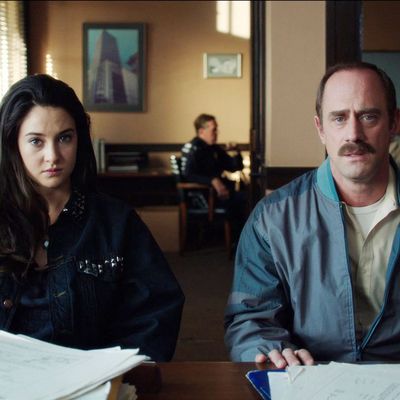
“I was 17 when my mother disappeared,” Kat Connor (Shailene Woodley) tells us in the opening narration of White Bird in a Blizzard. “Just as I was becoming nothing but my body — flesh and blood and raging hormones — she stepped out of hers and left it behind.” It’s a poetic yet somewhat simplistic comparison, and it captures the conflicting impulses in Gregg Araki’s evocative, gorgeous, occasionally maddening film.
White Bird is a coming-of-age tale that hops between the disappearance of Kat’s mother Eve (played by the great Eva Green, displaying a nutty blend of fierce allure and tense chill) and Kat’s own sexual awakening. The timeline hopscotches back and forth over a three-year period. We see the dysfunction at home, as the glamorous Eve seems so out of place in her static, sexless suburban marriage to seemingly straitlaced office drone Brock (Christopher Meloni); we see Kat start to mature sexually, first with hunky, dim Phil (Shiloh Fernandez), then, after Eve vanishes, with the 40-something Detective Scieziesciez (Thomas Jane), who’s investigating the disappearance. (This being a Gregg Araki movie, there’s plenty of skin.)
Eve comes off as wild combination — loving, withholding, abusive, smothering, distracted, judgmental — and Kat never quite knows what to make of her. There are little echoes here and there of Eve’s life in Kat’s. Phil starts to withhold sex and grow distant from Kat, similar to how the girl’s parents no longer seem willing to touch each other. The wonder and promise of youth, we observe, can grow rotten with the relentlessness of time. At one point, Kat flashes back to her own parents’ wedding, trying to grasp the sense of possibility they must have felt — a beautiful, all-American couple with the world open before them. Mother and daughter, it appears, are entwined in ways that aren’t at first apparent — as suggested by the film’s signature dream sequence, of Kat, all dressed in white, caught in a lushly artificial blizzard, coming upon a naked Eve lying in the snow.
The film doesn’t always seem willing to let us make these connections on our own, it seems. The dialogue and narration are often too on-the-nose. “She named me Katrina so she could call me Kat. She always wanted a pet … For years, I thought I was her pet,” Kat explains, helpfully, about her mother. Later, she notes that she would catch her mother “staring at me, like I’d stolen something that belonged to her.” As if to hold our hands even more, Eve then chimes in: “You looked like I looked when I was your age.” There may be a subtle reason for this: The connections are being forged by Kat herself, in what may be an act of wish fulfillment — which becomes clearer as we start to learn the real reasons for Mom’s frustrations, and for her disappearance. (Revelations which, I should add, are handled somewhat clunkily, though perhaps intentionally so: Araki likes his melodrama presented as directly as possible.)
Woodley and Green are such fine actors, though, and so well-matched — Woodley’s hesitancy playing off Green’s inner fire — that they help smooth over some of the film’s dodgier elements. The mother’s disappearance is both a curse and a blessing, it seems: The daughter can fill the woman’s psyche with her own hopes, dreams, and fears. And so, those obvious connections being forged, it seems, may just be illusions. That might explain why White Bird in a Blizzard tries so hard to walk a fine line between beguiling subtlety and frustrating, even intentional obviousness. And also why it sometimes strays too far from that line to truly succeed.





